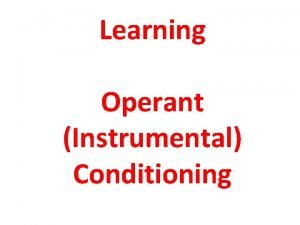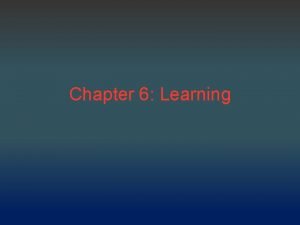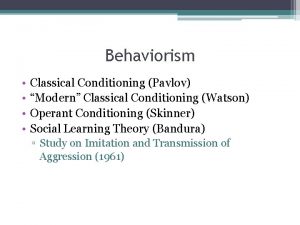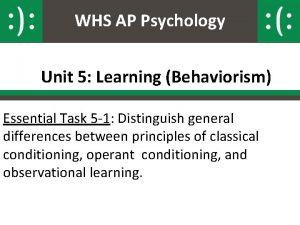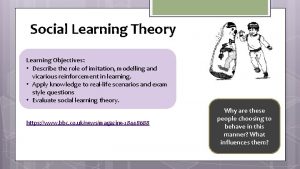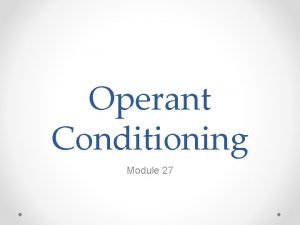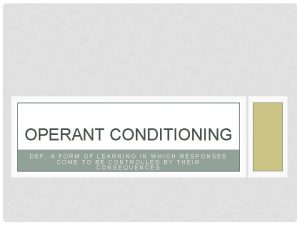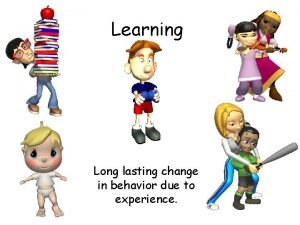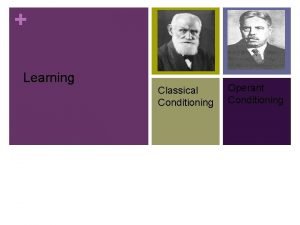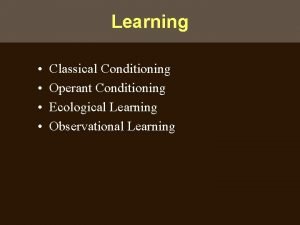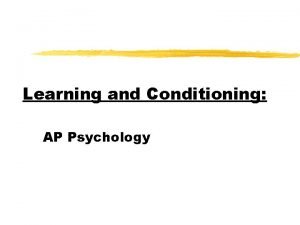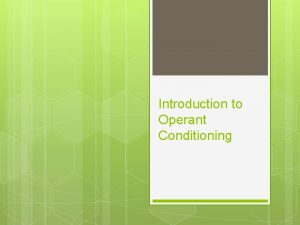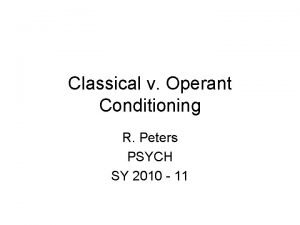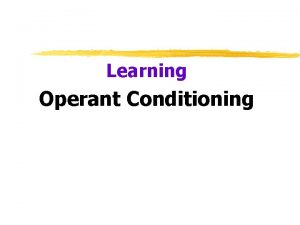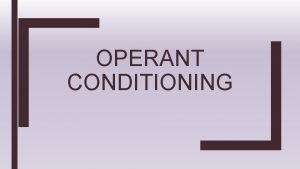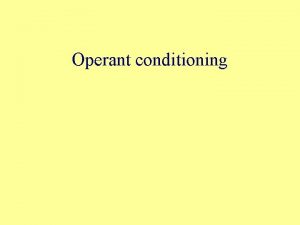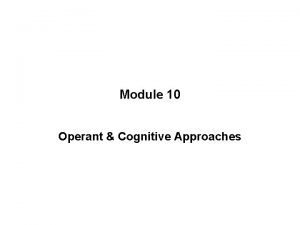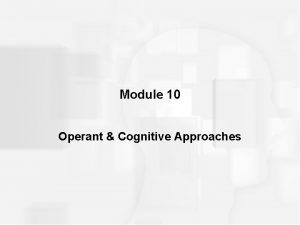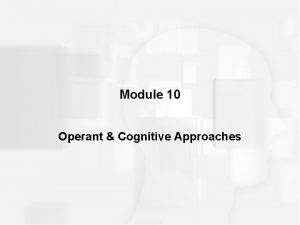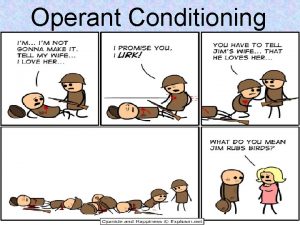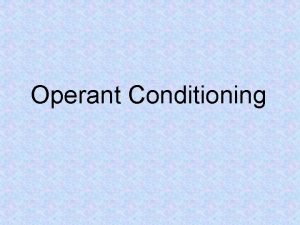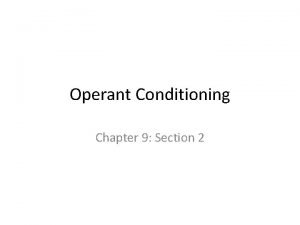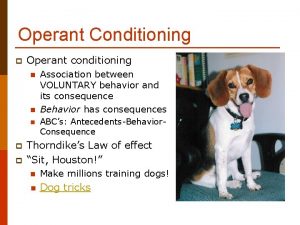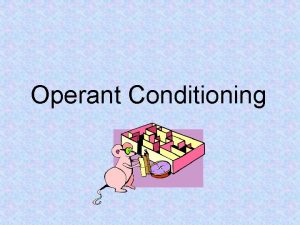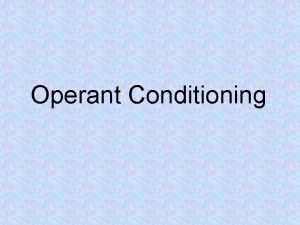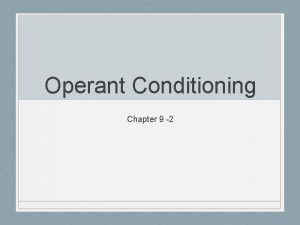Operant or Instrumental Conditioning Psychology 3306 Introduction l

























- Slides: 25

Operant or Instrumental Conditioning Psychology 3306

Introduction l l l Thorndike and his puzzle boxes Guthrie and Horton Superstitious Behaviour l l Interim Terminal Adjunctive Not exactly superstitious or random

Shaping l Successive approximations l Get l closer and closer to behaviour Secondary reinforcers l Feeder l click for example Behaviour modification

Freddie! l l l Coined the phrase ‘Operant conditioning’ The animal operates on the environment Unlike ‘respondent conditioning’ (Pavlovian) Pioneered the use of free operants Pioneered the use of respone rate

The Skinner Box l l Basically this allowed the researcher to walk away Allowed for a dependent variable that could be easily measured and compared across species too


Criticisms of the Skinner box Is it artificial? l Well duh… l But l Many species can be tested l Real world applications l Therapy l Who cares? l

Key concepts and terms Discriminative stimulus l Three term contingency l Acquisition l Extinction l Spontaneous recovery l Generalization l Conditioned reinforcement l Response chains l

Constraints Instinctive drift and the Brelands l Autoshaping (Brown and Jenkins, 1968) l l Superstitious behaviour? l Form of response depends on reinforcer (Jenkins and Moore, 1973) l Wasserman’s chicks (1973) l Timberlake’s behaviour systems approach

Schedules of Reinforcement You could give a reinforcement after each behaviour you are interested in l This is called CRF or Continuous reinforcement l However this is rarely used l Does not maintain behaviour very well l

Schedules of Reinforcement l Fixed Interval l First response after a given interval is rewarded FI Scallop Variable Interval l l Like FI but varies with a given average Scallop disappears

Schedules of Reinforcement l Fixed Ratio l l l Reinforcement is given after a given number of responses A little less smooth Variable Ratio l After a varying number of responses

Schedules and their properties Variable schedules are more robust l PREE, Partial reinforcement extinction effect l l Harder to extinguish responding on VI, FI, VR and FR than on CRF DRL, Differential reinforcement for low rates of responding l DRH, High rates l

Schedule this…. Concurrent and chained schedules l Behaviour follows the schedule in effect at the time l Allowed people to determine that the post reinforcement pause in FR schedules is due to the present schedule and not the previous one l

Applications l Work with autistic kids l Prompts l Fading l Secondary reinforcers Token economies l I/O applications l Behaviour therapy l

These ideas are nothing new… Most folks are unaware of schedules and contingencies l Systematic application thereof l Who cares? l

Punishment and avoidance Behavior increases Stimulus Presented Stimulus Removed or omitted decreases Positive reinforcement punishment Negative reinforcement Omission

Avoidance Shuttle box l Go from escape to avoidance l Avoidance paradox l Two factor theory l Avoid by escaping CS l Animals will avoid a CS that predicts shock in another context l

But…. Does the CS induce fear? l Equivocal at best l Maybe avoidance itself is reinforcing l This is the one factor theory l The Sidman test shows that this is true, avoidance itself is reinforcing l But, temporal conditioning l

Cognitive theories Selligman and Johnston l Expectations l Animal expects: l l No shock if it responds l Shock if it does not respond This explains the slow extinction l Shock avoidance response blocking, remove the ability to escape, you get extinction l

More on avoidance Bob Bolle’s idea about SSDRs l Learned helplessness l Is it depression? l l Suggestive, but not quite I don’t think

Punishment Opposite of reinforcement? l Sorta l But, to be effective it must be: l l Introduced at full intensity l Given immediately l After every behaviour Motivational effects l Other contingencies and behaviours l

Bad boys bad boys, watcha gonna do? Maybe a punisher is an SD? l All that said punishment CAN control behaviour l So, what’s the down side? l

punishment Fear and anger are bad for learning l General suppression l Constant monitoring needed l Avoidance l Reluctance to use it l Bad consequences l It is just plain mean l

Omission The avoidance of punishment l Easily learned l With all this stuff on punishment, remember morality and data are two different things l
 Operant vs classical
Operant vs classical Instrumental or operant conditioning
Instrumental or operant conditioning Operant conditioning vs classical conditioning
Operant conditioning vs classical conditioning Vicarious reinforcement
Vicarious reinforcement Variable ratio schedule of reinforcement
Variable ratio schedule of reinforcement Operant vs classical conditioning
Operant vs classical conditioning Classical conditioning and operant conditioning
Classical conditioning and operant conditioning Fixed ratio schedule example
Fixed ratio schedule example Operant and classical conditioning
Operant and classical conditioning Classical conditioning vs operant conditioning
Classical conditioning vs operant conditioning Operant conditioning classical conditioning
Operant conditioning classical conditioning Behaviorism ap psych
Behaviorism ap psych Operant conditioning
Operant conditioning Social learning objectives
Social learning objectives Partial reinforcement
Partial reinforcement Puzzle box skinner
Puzzle box skinner Operant conditioning examples positive reinforcement
Operant conditioning examples positive reinforcement Fixed interval
Fixed interval Skinner box
Skinner box Fixed ratio schedule of reinforcement
Fixed ratio schedule of reinforcement An event that leads to lasting change
An event that leads to lasting change Classical conditioning
Classical conditioning Social learning theory vs operant conditioning
Social learning theory vs operant conditioning Insight learning ap psychology
Insight learning ap psychology The essentials of conditioning and learning
The essentials of conditioning and learning Operant conditioning examples
Operant conditioning examples

